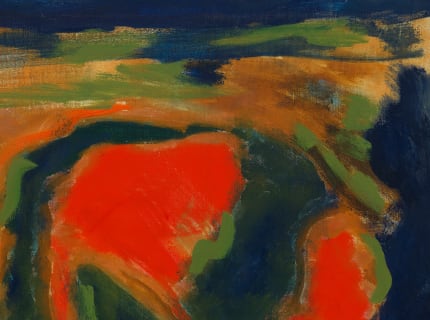The list of Betty Parsons’s adventures and accomplishments is immense.
As a gallerist, she gave Jackson Pollock, and myriad other Abstract Expressionists, some of their earliest shows. As a magnetic free spirit, she played tennis with Greta Garbo and danced weekly with Alexander Calder “for the exercise.” She topped her head with berets, took lovers like Josephine Baker, and traveled the world many times over.
Art history has remembered Parsons for all of these traits and triumphs. But the aspect of Parsons’s experience that made her happiest, has been largely ignored: her own art.
“When I’m not at the gallery, my own art is my relaxation,” Parsons said in a 1977 interview published in Art in America. “That’s my greatest joy.”
Parsons’s work is currently the subject of a spellbinding, long-overdue New York retrospective, “Invisible Presence,” on view at Alexander Gray Associates through July 14th. It celebrates her experimental practice with a selection of sculptures and paintings she made between 1922, when she was 22 years old, and 1981. For Parsons, her life as an artist predated her career as gallerist and continued—without pause—until her death in 1982.
“We’re trying to understand Betty Parsons the artist, aside from her role as a great dealer,” explains Alejandro Jassan, associate director at Alexander Gray Associates, of the motivation for the show. “Not many people are aware that she was a painter—and a very prolific and good one at that.”
The gallery began representing Parsons’s estate this May. “Invisible Presence” is its first of hopefully many shows to uncover her vast and inspired output—as well as connect meaningful dots between her personal practice and her role as a bellwether of Modern Art.
Parsons was born Betty Bierne Pierson in 1900 to a wealthy New York family. By age 13, she was already showing signs of rebellion from the role of high-society debutante she was expected to assume. After she visited the notorious 1913 Armory Show—where works by Matisse and Duchamp scandalized American audiences—she resolved to become an artist.
To Parsons, the radical art that she saw captured a “new spirit,” a phrase that doubled as her teenage mantra. In one interview, she recounted catching herself repeating “I am the New Spirit” as she strolled down Fifth Avenue.
Her trip to the Armory Show sparked a period of classes with Gutzon Borglum, the artist best known as Mount Rushmore’s infamous sculptor. But Parsons’s art studies slowed when she married socialite Schuyler Livingston Parsons in 1919. It was an unhappy union, and in 1922, she hightailed it to Paris. There, she divorced her husband and signed up for sculpture classes at Antoine Bourdelle’s Academie de la Grande Chaumière, where she rubbed elbows with the likes of Alberto Giacometti.
...
Read full review at artsy.net.

